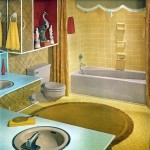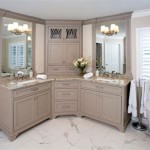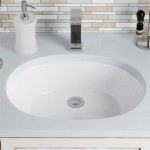The Biggest Selection of Bathroom Vanities: A Comprehensive Guide
The bathroom vanity serves as a focal point within the bathroom space, providing essential storage, counter space, and a surface for the sink. Choosing the right vanity requires careful consideration of size, style, material, and functionality. The market offers a vast array of bathroom vanities, catering to diverse design aesthetics, spatial constraints, and budgetary limitations. This article aims to provide a comprehensive overview of the extensive selection available, guiding consumers through the key factors to consider when selecting a vanity that perfectly complements their bathroom.
Understanding the Different Types of Bathroom Vanities
The primary categorization of bathroom vanities revolves around their installation type. These include freestanding, wall-mounted, corner, and vessel sink vanities, each offering unique advantages and considerations for space utilization and design.
Freestanding Vanities: These are the most common type, standing directly on the floor. They offer easy installation and a wide range of styles, from traditional to contemporary. Freestanding vanities typically provide ample storage space behind doors and within drawers. They are suitable for bathrooms of various sizes and styles, offering flexibility in placement and design integration. A key advantage of freestanding vanities is their ease of replacement; homeowners can swap them out without significant structural modifications.
Wall-Mounted Vanities (Floating Vanities): As the name suggests, these vanities are mounted to the wall, creating a floating appearance. This design enhances the perception of space and allows for easier cleaning underneath. Wall-mounted vanities tend to have a more modern and minimalist aesthetic, making them ideal for contemporary bathrooms. However, their storage capacity may be somewhat limited compared to freestanding options. The installation of wall-mounted vanities requires careful attention to wall reinforcement to ensure adequate support for the vanity and its contents.
Corner Vanities: Optimizing space in smaller bathrooms, corner vanities are designed to fit snugly into a corner. They are particularly useful in tight layouts where maximizing floor space is crucial. While their storage capacity may be limited, corner vanities provide a practical solution for smaller bathrooms without compromising on functionality. The design options for corner vanities are diverse, ranging from traditional to modern styles, allowing them to integrate seamlessly into various bathroom designs.
Vessel Sink Vanities: These vanities are designed to accommodate vessel sinks, which sit on top of the countertop rather than being recessed. Vessel sink vanities typically have a lower profile to allow the vessel sink to sit at a comfortable height. This type of vanity can add a unique and stylish element to the bathroom. The design of vessel sink vanities can range from rustic to contemporary, providing a wide array of options for homeowners seeking a distinctive bathroom design.
Exploring the Variety of Vanity Materials
The materials used in constructing a bathroom vanity significantly impact its durability, appearance, and overall cost. Common materials include wood, MDF (Medium-Density Fiberboard), particleboard, and various countertop materials such as granite, marble, quartz, and laminate.
Wood Vanities: Solid wood vanities are prized for their natural beauty, durability, and longevity. Common wood types include oak, maple, cherry, and walnut. Wood vanities offer a warm and inviting aesthetic, suitable for traditional and transitional bathroom designs. However, solid wood is susceptible to moisture damage if not properly sealed and maintained. Regular sealing and proper ventilation are essential to prevent warping, cracking, and rotting.
MDF Vanities: MDF is an engineered wood product made from wood fibers bonded together with resin. It offers a smooth, consistent surface that is ideal for painting or applying veneers. MDF is less expensive than solid wood and is less prone to warping and cracking. However, it is more susceptible to water damage than solid wood and requires careful sealing and protection from moisture. MDF is a popular choice for vanities in a wide range of styles due to its affordability and versatility.
Particleboard Vanities: Particleboard is another engineered wood product made from wood chips bonded together with resin. It is the least expensive option but is also the least durable and most susceptible to water damage. Particleboard is typically used for less expensive vanities. Due to its lower durability, particleboard vanities may not be suitable for high-moisture environments or for bathrooms that experience heavy use.
Countertop Materials: The countertop material significantly impacts the overall look and functionality of the vanity. Granite and marble offer luxurious aesthetics and excellent durability but require sealing to prevent staining. Quartz is a durable and low-maintenance option that is resistant to stains and scratches. Laminate is a cost-effective option that comes in a wide range of colors and patterns but is less durable than natural stone or quartz. The choice of countertop material should consider both aesthetic preferences and practical considerations such as durability, maintenance requirements, and budget.
Analyzing Styles and Design Aesthetics
Bathroom vanities are available in a plethora of styles, ranging from traditional and rustic to modern and contemporary. The chosen style should complement the overall design of the bathroom and reflect the homeowner's personal preferences.
Traditional Vanities: Characterized by ornate details, raised-panel doors, and classic hardware, traditional vanities evoke a sense of elegance and timelessness. These vanities often feature rich wood finishes and intricate carvings. Traditional vanities are well-suited for bathrooms with a classic or formal design aesthetic. They often incorporate elements such as turned legs, crown molding, and antique-style hardware.
Rustic Vanities: Embracing natural textures and distressed finishes, rustic vanities bring a touch of warmth and charm to the bathroom. These vanities often feature reclaimed wood, exposed hardware, and simple, functional designs. Rustic vanities are ideal for bathrooms with a farmhouse or country-inspired aesthetic. They may incorporate elements such as barn door hardware, rough-hewn wood, and natural stone accents.
Modern Vanities: Sleek lines, minimalist designs, and a focus on functionality define modern vanities. These vanities often feature flat-panel doors, clean hardware, and a neutral color palette. Modern vanities are well-suited for contemporary bathrooms with a minimalist or urban design aesthetic. They often incorporate elements such as integrated sinks, floating designs, and geometric shapes.
Contemporary Vanities: Combining elements of modern and traditional design, contemporary vanities offer a balanced and versatile aesthetic. These vanities often feature clean lines, simple hardware, and a mix of materials and finishes. Contemporary vanities are suitable for a wide range of bathroom styles. They may incorporate elements such as floating designs, vessel sinks, and a mix of wood and metal finishes.
In addition to these primary styles, there are numerous variations and sub-styles to consider, such as transitional, industrial, and coastal. Transitional vanities bridge the gap between traditional and modern design, offering a balanced blend of classic and contemporary elements. Industrial vanities embrace raw materials and utilitarian designs, often featuring exposed pipes and metal accents. Coastal vanities evoke a beachy and relaxed vibe, with light colors, natural textures, and nautical-inspired details.
When selecting a bathroom vanity, it is crucial to consider the overall style and design of the bathroom. The vanity should complement the existing fixtures, finishes, and color palette to create a cohesive and harmonious space. Homeowners should also consider their personal preferences and lifestyle when choosing a vanity style. The vanity should not only be aesthetically pleasing but also functional and practical for daily use.
The selection of bathroom vanities is extensive, offering options to suit every taste and budget. By understanding the different types, materials, and styles available, consumers can make informed decisions and choose a vanity that enhances the beauty and functionality of their bathroom. Careful consideration of factors such as size, storage needs, and design preferences will ensure that the chosen vanity perfectly complements the bathroom space and meets the homeowner's individual needs.
Furthermore, the availability of custom-made vanities provides an opportunity to tailor the product perfectly to individual needs and spatial constraints. This option allows for greater control over dimensions, materials, and finishes, ultimately leading to a truly unique and personalized bathroom design.

14 Best Bathroom Vanity S Where To Buy Vanities

14 Places To Buy An Affordable Bathroom Vanity Hunker

Best Selection The Naples Bath Vanity With Double Sink Dual Cabinet One Time Bathroom Collection Wall

Bathroom Vanities Handy Man Home Remodeling Center

Bathroom Vanities The Home Depot

Best Wood Bathroom Vanity Jkath Design Build Reinvent

9 Tips For Choosing A Bathroom Vanity Your Home

The 14 Best Places To Buy A Bathroom Vanity In 2024 Bob Vila

35 Best Bathroom Vanities 2024
What Are The Best Materials For Bathroom Vanity Countertops Toulmin Kitchen Bath
Related Posts







